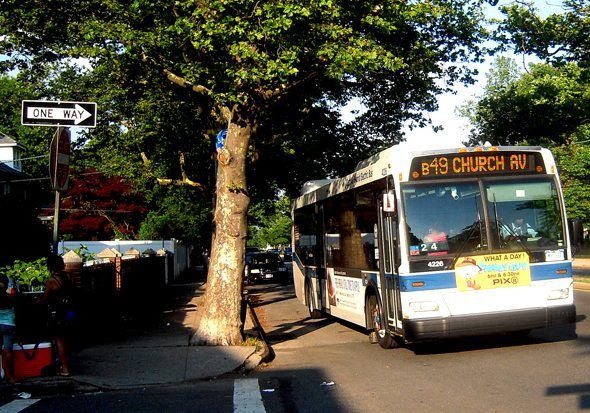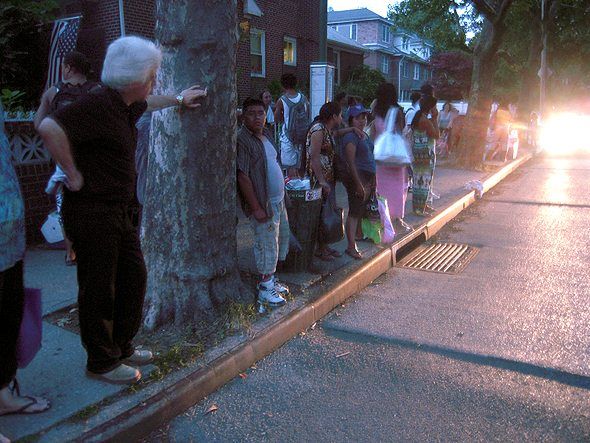You Shouldn’t Have To Wait An Hour For The B49

THE COMMUTE: Although buses are scheduled at 10 minutes intervals, if you were trying to get home from Manhattan Beach on the evening of July 4, there is a good chance that you would have had to wait for an hour for a B49. Two weeks ago I reported long waits on both the B1 and B49 buses on a hot summer weeknight during the rush hour, and how service is disrupted on an entire route because the MTA does not pay attention to heavy beach loadings. I decided to return on July 4 to see if conditions would be better or worse.
Since it was very hot again, and a holiday, most people did not start to leave the beach until 7:00 p.m. or later with loadings fairly light before then. Between 5:40 p.m. and 6:30 p.m., B1 buses left Falmouth Street at the following times: 5:40 p.m., 6:13 p.m., 6:23 p.m., and 6:30 p.m. — not quite every 10 minutes as promised. The B49 left at 5:40 p.m., 6:02 p.m., 6:29 p.m., and 6:31 p.m. (the latter being to Church Avenue only, as pictured above) — also not as promised. Each route was two buses short, about two-thirds the scheduled service, during the time I was watching.
As I discussed last time, the allowed running time does not allow for the extra crowds of people boarding to go to and from the beach and, subsequently, it is impossible for buses to maintain their schedule. A bus can lose at least 10 minutes per trip. Rather than making up some of that time by shortening their recovery period, buses were observed taking anywhere from 10- to 20-minute layovers. Now, if you are going to lose 10 minutes on each trip, and not make up any of that time, it stands to reason that near the end of your shift you could be close to an hour behind schedule. That means you either cut one of your trips short, or, kill an extra 20 minutes laying over and skip your final trip of the day altogether. That is why only eight buses left the terminal when 12 were scheduled.
Where are the MTA statistics on scheduled trips that are not provided? Those statistics, if not made public, should at least be made available to the MTA Board, and costs should be determined using actual trips made — not fictional, scheduled trips. Allowing insufficient running time lowers the cost per trip on paper, but this means nothing if all trips are not actually made, which they are aren’t.
Since there was no overcrowding before 7:00 p.m., only erratic waits for buses, I decided to return after dinner to see the real problems. I arrived at 8:20 p.m., just as a B1 bus left Falmouth Street with approximately 40 passengers aboard. At 8:24 p.m. there were 70 people, all waiting for the B49. That appeared to be about a 20-minute crowd waiting since around 8:00 p.m. At 8:24 p.m., B49 bus 9391 bypassed the stop already fully loaded from picking up at Jaffrey Street and Hastings Street. At 8:42 p.m., a second B49, bus 5174, also bypassed Falmouth Street fully loaded. A portion of the crowd then decided to walk to Jaffrey Street or Hastings Street where they would have a better chance of getting on the next bus. This picture shows the remaining crowd at 8:47 p.m.

At 8:51 p.m., two B1 buses came by, one stopping and picking up all the B1 passengers and the other bypassing the stop altogether. Both buses were not crowded, although there was a 30-minute gap in B1 service. Finally, at 8:56 p.m., B49 bus 4226 stops at and leaves Falmouth Street with a full load of about 75 passengers after spending three minutes at that one stop loading. It was now close to an hour since the previous B49 bus stopped there. If bus 4226 bypassed future stops, which was a good possibility, the next bus would not have arrived for yet another 13 minutes.
Although bus 4226 did not arrive at Falmouth Street until 8:53 p.m., it was observed going in the reverse direction to Mackenzie Street at 8:36 p.m. If it spent a combined five minutes at Hastings Street and Jaffrey Street picking up passengers, the bus still took a 10-minute layover when it was already late.
If you were astute, you would have noticed that bus 4226 was the same bus destined for Church Avenue earlier in the day leaving Kingsborough at 6:30 p.m. Since there was enough time for the bus to make it all the way to Fulton Street by the time it returned to Kingsborough at 8:38 p.m., cutting short the scheduled trip from Fulton Street to Church Avenue enabled the bus operator to take his 30-minute lunch break at Church Avenue, which meant that he was already 30 minutes late after only a half day of work.
Again, who is keeping statistics on trips cut short and trips not made at all due to inadequate running time and the failure of the MTA to assign extra buses for heavy passenger loads? These factors throw entire bus schedules into chaos.
Bus Time
On July 1st, the MTA expanded Bus Time to the B61 in Red Hook and Park Slope. I previously alluded that Bus Time could be what the MTA needs to finally get its buses on schedule since it will be possible to see where all the buses on a route are at the same time. I decided to give it a test and was not at all impressed. The biggest problem is, unlike the subway countdown clocks that give an estimated wait time in minutes, Bus Time can only presently give you the wait in terms of miles (The MTA has yet to convert miles to minutes because of traffic conditions, which it cannot now estimate). What you learn is that the bus is one or two stops away, something you can usually see just by looking up the street, or the number of miles the bus is from your stop. So after seeing where the buses were using Bus Time, I decided to ask for the wait where there was a big gap between buses. It told me the next bus was 4.5 miles away. That could be anywhere from 30 minutes to an hour away depending upon if the bus’ speed is 4.5 or nine miles an hour. Not very helpful.
I checked a second location and was told there were no buses en route. There was a bus going in the opposite direction, one block from the terminal, but apparently Bus Time cannot see around terminals. That is a big problem if you are boarding near the beginning of a route. A bus could be 10 minutes away, and you would never know. You would get a better idea when the next bus is coming simply by watching buses going in the opposite direction.
Until Bus Time can estimate time in minutes and can see around terminals, its use is very limited. Further, if it is not used to help keep buses on schedule, the MTA would not be making use of its potential. When watching Bus Time on the B61, I also noticed there were five B61s all traveling in one direction and only two going in the other. One bus also spent 15 minutes at its Downtown Brooklyn terminus, allowing the gap between it and its leader to get bigger and bigger. Now why isn’t the MTA using Bus Time to better regulate the B61?
The MTA soon will have the ability to really help the passenger — by reducing bus bunching and also have the information to write better schedules. Will bus reliability be improved as a result of Bus Time, or will we hear more excuses as to why waiting for a bus has to be a crapshoot?
Other News
Assemblyman Bill Colton presented his petition to restore B64 service to the MTA Board on June 27th.
In my series, last March, “The Role of Buses and How to Make Them More Effective,” I asked why the MTA could not operate express bus routes between major interborough commercial centers. I suggested that a market exists, judging from illegally-operated buses between Chinatown and Flushing. The New York Times recently had an interesting article on this subject showing how private enterprise fills in when MTA service falls short.
As passengers were waiting an hour in Manhattan Beach for the B49 on July 4th, others were taking car service. I overheard one conversation between four girls and a driver. “How much to the Junction?” “That will be $25.” And off they went.
The Commute is a weekly feature highlighting news and information about the city’s mass transit system and transportation infrastructure. It is written by Allan Rosen, a Manhattan Beach resident and former Director of MTA/NYC Transit Bus Planning (1981).
Disclaimer: The above is an opinion column and may not represent the thoughts or position of Sheepshead Bites. Based upon their expertise in their respective fields, our columnists are responsible for fact-checking their own work, and their submissions are edited only for length, grammar and clarity. If you would like to submit an opinion piece or become a regularly featured contributor, please e-mail nberke [at] sheepsheadbites [dot] com.